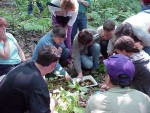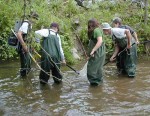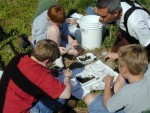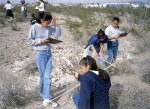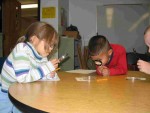The National Science Foundation's (NSF) has awarded researchers from four Long Term Ecological Research (LTER) sites, 11 universities, and K-12 school districts from across the nation a $12.5 million grant to enhance environmental science literacy. The grant by NSF's Mathematics and Science Partnership program aims to create a dynamic teacher development program targeted at middle school and high school teachers in the science, technology, engineering and mathematics (STEM) disciplines.
Colorado State University (CSU) is the lead institution in the program, which will create a framework where environmental science literacy drives learning of core science and mathematics concepts. John Moore, a co-principal investigator at the Shortgrass Steppe (SGS) LTER site and director of CSU's Natural Resource Ecology Laboratory, will oversee the program.
The LTER Network Office, based in the Biology Department at the University of New Mexico, will work to create a clearing house of opportunity for research for students and teachers based on activities at the 26 LTER sites and try to match teachers and students with appropriate research and education programs.
The collaborative program will connect the research prowess of the environmental sciences and education of partner universities and sites within the 26-member LTER network, which is also funded by NSF, with K-12 science and math teachers in partner schools and districts. The focus will be on human-ecosystem interactions to develop culturally relevant ecology from both a scientific and educational perspective.
"Dr. Moore and his colleagues have done a great service by translating the education goals of the Decadal Plan for LTER into a proposal that will allow us to move forward on a path to achieve these goals," said Robert Waide, executive director of the LTER Network Office. "The LTER Network is committed to developing an approach that integrates research and education across the entire educational continuum."
Providing teachers with content knowledge and increasing student preparation and interest in STEM disciplines is an urgent need across the US. Collectively, the four LTER research sites will partner with 22 K-12 schools/districts in their regions, focusing exclusively on middle schools and high schools serving more than 250 science and mathematics teachers and 70,000 students across the United States.
"Ultimately, our plan is to develop, implement and disseminate our models through the LTER Network Office, which each year interacts with upwards of 1,000 teachers and impacts nearly 500,000 students of diverse ethnicities across the United States," said Moore.
Collaborators on the project aim to develop models of professional development that integrate the research efforts of scientists with the professional development needs of teachers. They plan to include a teacher-in-residence program, research internships for teachers, placement of graduate students into K-12 classrooms, professional development workshops leading to graduate credit and degrees, and professional learning communities.
Additionally, grant collaborators will examine existing K-12 curriculum to refine and extend current learning pathways leading to environmental science literacy and associated mathematics. The themes for this activity will include carbon cycling, water systems, and biodiversity in socio-ecological systems.
Core partners on the NSF-funded grant are
- Greeley-Evans School District #6 (CO)
- Poudre School District (CO)
- Michigan State University (MI)
- Plainwell Community Schools (MI)
- University of California, Santa Barbara (CA)
- Santa Barbara School District (CA)
- Cary Institute of Ecosystem Studies (NY)
- Towson University (MD)
- Baltimore City and County Public Schools (MD)
- University of Northern Colorado (CO)
- University of Wyoming (WY)
- LTER Network Office (NM)

 Enlarge this image
Enlarge this image